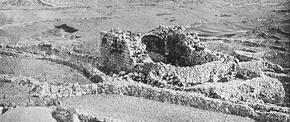The views expressed in our content reflect individual perspectives and do not represent the authoritative views of the Baha'i Faith.
The diametrically opposed political and social perspectives of the Baha’i Faith and the Nazi regime are evident in letters from the Faith’s leadership to the German Baha’i community.
That guidance, which responded directly to the increasingly worrisome, repressive events beginning in the early 1930s and directed toward the German Baha’i community from the Nazi regime, can help us understand how a peaceful faith community responds to repression.
In 1934 Shoghi Effendi, the Guardian of the Baha’i Faith after the passing of Abdu’l-Baha in 1921, wrote to the German Baha’i governing body, its National Spiritual Assembly, responding to their inquiries about how to proceed under Nazi rule in the context of the Faith. In his letter, Shoghi Effendi stressed the supreme importance of obedience and peace, but acknowledged that Hitler’s policies and ideas “cannot be fully reconciled” with the “Baha’i philosophy of social and political organization.”
RELATED: What Happened to Germany’s Baha’is During the Nazi Regime?
He also warned that the “wave of nationalism, so aggressive and so contagious” that has “swept not only over Europe but over a large part of mankind” fundamentally contravenes the Baha’i teachings of “peace and brotherhood.” He further cautioned that “the world is drawing nearer and nearer to a universal catastrophe” because governments were moving in an extremist direction. He stated that while obedience is critical, one’s belief in and practice of the Faith should not be compromised in any way, even if it may result in death. He advised that Baha’is:
… should obey the government under which they live, even at the risk of sacrificing all their administrative affairs and interests, they should under no circumstances suffer their inner religious beliefs and convictions to be violated and transgressed by any authority whatever.
In 1938, a year after the Nazis banned the practice of the Baha’i Faith in Germany, a representative of Shoghi Effendi wrote to the German followers on his behalf to strategize a response to the local German authorities and the Gestapo. The Baha’is had written to the Guardian asking for advice on how to proceed after they had been notified that any Baha’i meetings were prohibited and their religious objects permanently confiscated. In response, the Guardian warned the German Baha’is, particularly in the region of Stuttgart, that further rebellion against the regime might “displease” the secret police and that the followers should “keep entirely silent, and not to press any longer their case by addressing any appeal either to the authorities in Stuttgart or Berlin.” The Guardian suggested instead that if feasible and safe, the followers should “endeavor to find new ways of approach” by contacting higher-level officials in the Gestapo, considering their organization “reigns supreme in the Germany of today.”
Much like his letter to the German Baha’is in 1934, the Guardian ended his address with the message that the world is growing increasingly tense and divided, urging them “to be prepared for still far more serious developments.”
However, the Guardian maintained that the Baha’is of Germany can be “assured and confident” in their faith and Abdu’l-Baha’s promise of a bright future for their community. Both letters from Shoghi Effendi reflect an extremely concerned yet hopeful perspective, and served as a guide for German Baha’is on how to conduct themselves and their religious activities under oppression. The unwavering faithfulness evident in Shoghi Effendi’s writings was similarly present in many German Baha’is, especially those who suffered the most severe consequences for their beliefs.
One example of the extreme persecution Baha’is faced under the Nazi regime was the arrest and execution of Lidia Zamenhof in Nazi-controlled Poland. Lidia, born in 1904 in Warsaw, was a teacher, writer, and translator who became involved in the Baha’i Faith as a young woman. The daughter of the Warsaw ophthalmologist L.L. Zamenhof, the creator of the universal auxiliary language Esperanto, Lidia was responsible for translating several essential Baha’i writings, and frequently wrote about and traveled to teach the tenets of the Faith. After spending time in the United States with the American Baha’i community, Zamenhof returned to her homeland of Poland in 1938, just before the start of World War II. After the German invasion of Poland, Zamenhof’s house was bombed, and she and her family were arrested.
She spent five months in prison before being sent to the Warsaw Ghetto. Her time in the ghetto was marked by her attempts to get food and medicine for the most vulnerable. She turned down an offer of escape from a German Baha’i soldier, in order to protect the others living in the ghetto from being retaliated against by the Nazis.
RELATED: The Impact of the Nazis on Today’s World
Zamenhof’s refusal to leave eventually resulted in her tragic demise, as she was transported via cattle car from the Warsaw Ghetto to Treblinka in 1942, where she was killed in the gas chamber upon her arrival. In her last known letter, she wrote: “… I know I must die but I feel it is my duty to stay with my people. God grants that out of our sufferings a better world may emerge. I believe in God. I am a Baha’i and will die a Baha’i. Everything is in His hands.”
Eva Toren, a young acquaintance of Zamenhof’s and a survivor of Treblinka, was with Lidia in her final hours. While the Nazis were shouting at and physically abusing their victims, Toren described Lidia as “walk[ing] regally, upright, with pride, unlike most of the other victims who were understandably panicked.” Lidia Zamenhof’s story is just one tragic example of the consequences Baha’is faced for simply practicing their Faith, but her final communications and conduct show an absolute refusal to compromise her beliefs, knowing it meant her death.

















Comments
Sign in or create an account
Continue with Facebookor